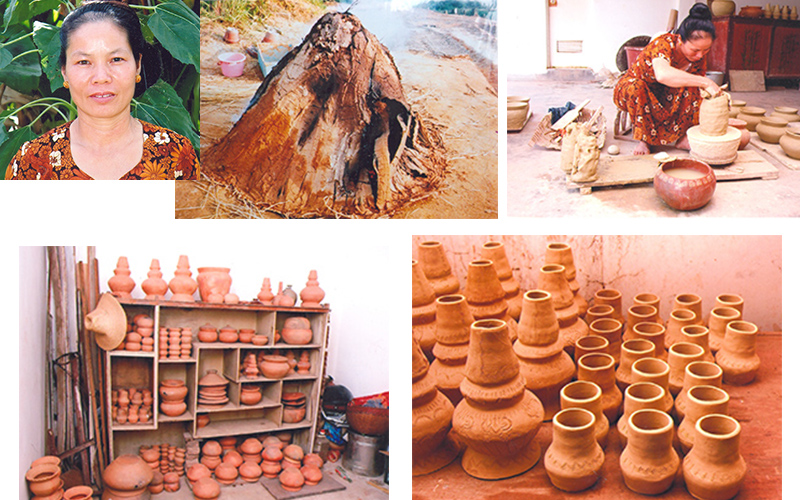 alt="Puer Surrounding Counties and Towns: Weekly & Special Local Markets Travel Guide"
/>
alt="Puer Surrounding Counties and Towns: Weekly & Special Local Markets Travel Guide"
/>
Yu Meng – Dai Pottery Maker in Jinghong City, Xishuangbanna
Yu Meng(玉勐), born in 1957, is a Dai pottery artisan from Mandou Village (曼斗村), Jinhong Subdistrict Office (景洪市街道办事处), Xishuangbanna Dai Autonomous Prefecture (西双版纳傣族自治州). As a national inheritor of China’s intangible cultural heritage for Dai slow-wheel pottery, she began learning the craft in childhood and started independent production in 1985. Her works include traditional Dai household items and Buddhist ceremonial objects, such as earthen pots, clay kettles, and water jars. These pieces, deeply rooted in ethnic traditions, are highly sought after by local communities.
Trained by her mother, Yu Xiangshuai (玉香甩), and mentored by veteran Dai potters Yan Pa (岩帕) and Bo Tao Xiangzhang (波涛香章), Yu Meng employs the ancient coiling technique with slow-wheel firing. Her process—from pounding and sifting clay to shaping, drying, and firing—relies entirely on manual skill and experience. Recognized internationally, she was invited to Japan’s World Ceramic Exposition, where her work earned widespread acclaim.
Beyond her craftsmanship, Yu Meng is dedicated to preserving this heritage. Since 1994, she has trained numerous apprentices and hosted free workshops for youth and enthusiasts. Her pieces are collected by the Chinese National Academy of Arts, and she holds honors like “Dai Artisan (傣乡工匠).” Her efforts have sustained Dai pottery’s legacy and fostered cultural exchange, notably between China and Japan.

International Acclaim for Yu Meng’s Pottery
High Praise in Japan
From July to September 1996, Yu Meng, alongside her daughter Yu Danhan (玉单罕) and apprentice Yu Layue (玉腊约), demonstrated slow-wheel pottery at the World Ceramic Exposition in Saga, Japan. Experts marveled at the traditional methods, intricate patterns, and rustic forms, particularly her “mantou kiln (馒头窑)” firing technique. This revelation helped Japanese scholars decode mysteries of their Yayoi period, earning accolades from archaeologists, historians, and artists. During the event, her team fired over 600 pieces across 20 kilns, elevating China’s ceramic reputation and strengthening Sino-Japanese cultural ties.
Hailed as “Ancient Yunnan’s Brilliance”
At the 1996 exposition, Yu Meng’s faithful revival of archaic techniques led experts to laud her work as “the pinnacle of ancient Yunnan’s ingenuity.”
A Key to Neolithic Pottery Mysteries
Since the late 1950s, global archaeologists have studied Dai pottery, identifying it as a living relic of China’s primitive ceramics. Regarded as “the key to unlocking Neolithic firing techniques,” it offers unparalleled insights into early pottery-making.
For Chinese version pleaese go to:
http://www.ynich.cn/view-ml-13111-3312.html

 7 Days GolfingTour
7 Days GolfingTour
 8 Days Group Tour
8 Days Group Tour
 8 Days Yunnan Tour
8 Days Yunnan Tour
 7 Days Shangri La Hiking
7 Days Shangri La Hiking
 11 Days Yunnan Tour
11 Days Yunnan Tour
 6 Days Yuanyang Terraces
6 Days Yuanyang Terraces
 11 Days Yunnan Tour
11 Days Yunnan Tour
 8 Days South Yunnan
8 Days South Yunnan
 7 Days Tea Tour
7 Days Tea Tour
 8 Days Muslim Tour
8 Days Muslim Tour
 12 Days Self-Driving
12 Days Self-Driving
 4 Days Haba Climbing
4 Days Haba Climbing
 Tiger Leaping Gorge
Tiger Leaping Gorge
 Stone Forest
Stone Forest
 Yunnan-Tibet
Yunnan-Tibet
 Hani Rice Terraces
Hani Rice Terraces
 Kunming
Kunming
 Lijiang
Lijiang
 Shangri-la
Shangri-la
 Dali
Dali
 XishuangBanna
XishuangBanna
 Honghe
Honghe
 Kunming
Kunming
 Lijiang
Lijiang
 Shangri-la
Shangri-la
 Yuanyang Rice Terraces
Yuanyang Rice Terraces
 Nujiang
Nujiang
 XishuangBanna
XishuangBanna
 Spring City Golf
Spring City Golf
 Snow Mountain Golf
Snow Mountain Golf
 Stone Mountain Golf
Stone Mountain Golf












 What Our Customers Say?
What Our Customers Say?
